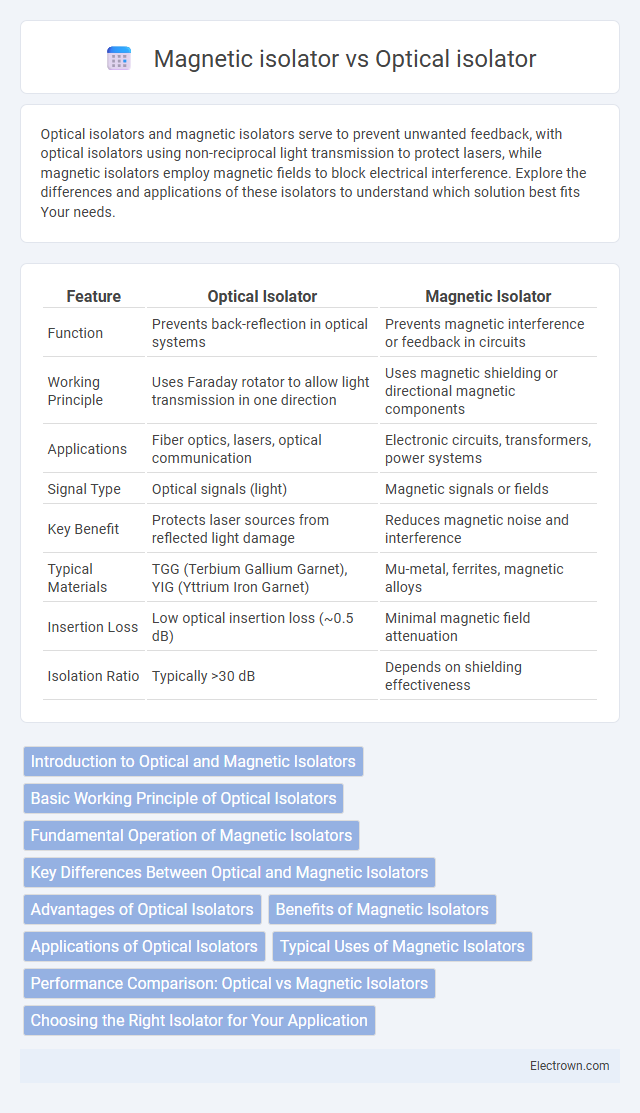Optical isolators and magnetic isolators serve to prevent unwanted feedback, with optical isolators using non-reciprocal light transmission to protect lasers, while magnetic isolators employ magnetic fields to block electrical interference. Explore the differences and applications of these isolators to understand which solution best fits Your needs.
Table of Comparison
| Feature | Optical Isolator | Magnetic Isolator |
|---|---|---|
| Function | Prevents back-reflection in optical systems | Prevents magnetic interference or feedback in circuits |
| Working Principle | Uses Faraday rotator to allow light transmission in one direction | Uses magnetic shielding or directional magnetic components |
| Applications | Fiber optics, lasers, optical communication | Electronic circuits, transformers, power systems |
| Signal Type | Optical signals (light) | Magnetic signals or fields |
| Key Benefit | Protects laser sources from reflected light damage | Reduces magnetic noise and interference |
| Typical Materials | TGG (Terbium Gallium Garnet), YIG (Yttrium Iron Garnet) | Mu-metal, ferrites, magnetic alloys |
| Insertion Loss | Low optical insertion loss (~0.5 dB) | Minimal magnetic field attenuation |
| Isolation Ratio | Typically >30 dB | Depends on shielding effectiveness |
Introduction to Optical and Magnetic Isolators
Optical isolators, essential in fiber optic communication systems, allow light signals to pass in one direction while blocking reflections that can damage lasers or disrupt data transmission. Magnetic isolators, commonly used in electrical and electronic circuits, utilize magnetic fields to prevent unwanted signal feedback and interference in AC and DC power systems. Both devices play a critical role in maintaining signal integrity and protecting sensitive components in their respective applications.
Basic Working Principle of Optical Isolators
Optical isolators operate on the principle of non-reciprocal light transmission, using the Faraday effect to rotate the polarization of light in one direction while blocking it in reverse, ensuring unidirectional signal flow in fiber optic systems. Magnetic isolators employ magnetic fields to achieve similar non-reciprocal behavior but rely on magnetic resonance or magneto-optic components for isolation. Optical isolators are essential in laser applications to prevent back reflections and maintain signal integrity by allowing light to pass only forward.
Fundamental Operation of Magnetic Isolators
Magnetic isolators operate by utilizing magnetic fields to suppress high-frequency noise and interference in electrical circuits, primarily through the use of ferrite cores that absorb and dissipate unwanted signals. Unlike optical isolators, which rely on the Faraday effect to allow unidirectional light transmission, magnetic isolators function by providing impedance matching and attenuation of reflected signals within RF and microwave systems. The fundamental operation involves the control of signal flow to prevent feedback and enhance system stability in telecom and signal processing applications.
Key Differences Between Optical and Magnetic Isolators
Optical isolators use the Faraday effect to allow light transmission in one direction while blocking reflections, essential in laser systems to prevent feedback and damage. Magnetic isolators rely on magnetic fields to restrict current or signal flow, commonly used for electrical surge protection or electromagnetic interference suppression. The primary difference lies in their operational domains: optical isolators manage photonic signals, whereas magnetic isolators control electrical or magnetic signals.
Advantages of Optical Isolators
Optical isolators offer significant advantages such as immunity to electromagnetic interference, compact size, and high-speed operation, making them ideal for fiber optic communication systems. Unlike magnetic isolators, optical isolators provide unidirectional light transmission without bulky magnetic materials, enhancing system reliability and efficiency. Your optical network benefits from reduced signal degradation and improved overall performance by integrating these advanced optical components.
Benefits of Magnetic Isolators
Magnetic isolators offer superior performance in high-frequency applications by effectively preventing electromagnetic interference and signal degradation. Their robust design ensures enhanced durability and reliability in harsh environments, making them ideal for industrial and communication systems. Choosing a magnetic isolator improves your system's stability and minimizes noise, ensuring optimal signal integrity.
Applications of Optical Isolators
Optical isolators are crucial in laser and fiber optic communication systems, preventing back reflections that can destabilize lasers and degrade signal quality. You find them widely employed in high-power laser setups, telecommunications networks, and optical sensing, where unidirectional light transmission enhances performance and device longevity. Magnetic isolators primarily serve in electrical circuits to prevent unwanted current flow, making optical isolators uniquely valuable in photonics applications.
Typical Uses of Magnetic Isolators
Magnetic isolators are commonly used in applications requiring protection of sensitive electronic equipment from high current surges, such as in industrial machinery, power supplies, and telecommunications systems. They effectively prevent damage caused by electrical interference or fault currents, ensuring the reliability and stability of your system. Unlike optical isolators, which are primarily used for signal transmission and noise reduction in fiber optics, magnetic isolators focus on electrical isolation and current interruption in high-power environments.
Performance Comparison: Optical vs Magnetic Isolators
Optical isolators offer superior performance in high-speed fiber optic communication systems due to their low insertion loss and high isolation ratio, typically exceeding 40 dB. Magnetic isolators, commonly used in RF and microwave applications, provide robust isolation but often exhibit higher insertion loss and limited bandwidth compared to optical isolators. The choice between these isolators depends on application-specific requirements such as frequency range, signal integrity, and environmental factors.
Choosing the Right Isolator for Your Application
Optical isolators provide unidirectional light transmission, making them essential for protecting lasers and sensitive optical components from back reflections and feedback. Magnetic isolators, often used in electrical circuits, prevent unwanted current flow and protect against voltage spikes, ensuring signal integrity and device safety. Choosing the right isolator depends on your application's nature--optical systems benefit from optical isolators, while electrical systems require magnetic isolators for effective isolation and protection.
Optical isolator vs Magnetic isolator Infographic

 electrown.com
electrown.com